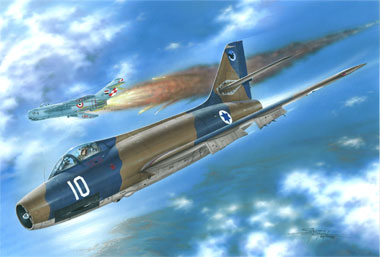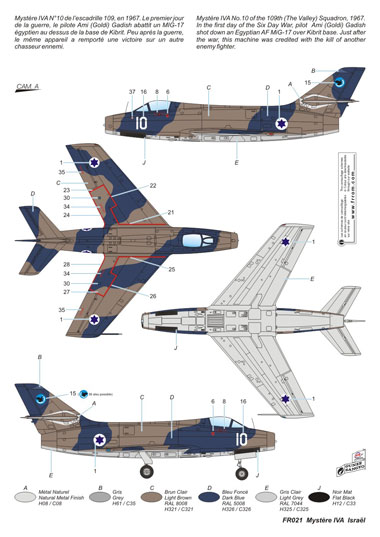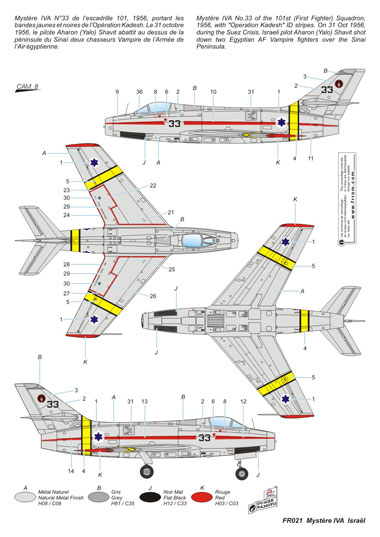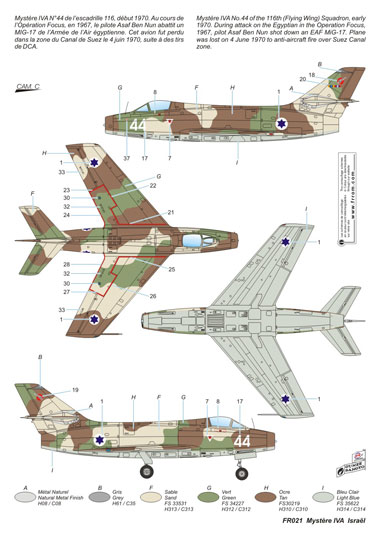FR021 Dassault Mystère IVA Israel
History:
The Ouragan (Hurricane) was the first of a long line of French jet fighters built by the Société des Avions Marcel Dassault. Design work commenced just after the end of WW2 in 1946, whilst its entry into service was a short time later in 1952. The next design, the Mystère II, was an evolution of the straight winged Ouragan. It had a 30° swept wing as well as modified tail surfaces, and entered service in the Armée de l’Air in the spring of 1955.

The Mystère IV was based on further refinement of the Mystère II design concept. It bore an external resemblance to the earlier plane, but it had a revised wing structure that was also strengthened. The Mystère IV prototype first flew on 28th September 1952; the pilot on this occasion being Constantin Rozanoff. The prototype proved to be a great success; so much so, that the Armée de l’Air ordered the first batch in October 1952. Eleven pre-production airframes were soon followed by the production version. This was the Mystère IVA (MD-454), of which 411 were built. The first 50 aircraft had the Rolls Royce Tay 250 turbojet, whilst the remainder used the slightly more powerful Hispano-Suiza Verdon 350; which was a licence built version of the Tay.
A US military mission chose the Mystère IVA for a production run that the USA would pay for. In the Mystère IVA’s case it funded the production of 225 aircraft for the Armée de l’Air.
The first unit of the Armée de l’Air to receive a production aircraft was the 12 éme Escadre, based in Cambrai (25th May 1955). The new fighter also served with 2 éme, 5 éme, 7 éme, 8 éme and 10 éme Escadres. The Patrouille de France air display team flew the Mystère from 1957 until 1963. After its withdrawal from first line units, it was employed in 8 éme Escadre at Cazeaux for advanced training, until November 1982, when it was replaced by the Aphajet in this role.
The Armée de l’Air and IDFAF flew the Mystère on operations during the Suez crisis of 1956.
France exported the Mystère IVA’s to India and Israel; it sold 110 to the former and 61 to the latter. This followed on from the success of the Ouragan that was already in service with these nations. India flew them in its wars with Pakistan (1965 & 1971).
Israel placed its first order for 24 Mystère IVA‘s in December 1955; which was soon followed by an order for 37 more in April 1956. The first six aircraft landed in Israel on 11 April 1956, and commenced service with the Israeli air force at Tayeset 101 (Hatzor airbase).
During the Suez Crisis they shot down an Egyptian MiG-15 on October 30th, followed the next day by four Vampires and two more MiGs. The Mystère flown by the leader of Tayeset 101, Benjamin Peled, was lost to Egyptian AA fire on the 2nd of November. During the crisis French Mystère units, EC 1/2 “Cigognes” and EC 3/2 “Alsace“ were sent to Ramat David airfield to protect Israeli towns (See kit: AZUR-FRROM FR020). Later on in their service lives Israeli Mystères switched to the ground-attack role and fought in the 1967 war.
Specifications: Wingspan 11.12m, Length 12.85 m, Wing Area 32 m2, Empty Weight 5,850 kgs, Max Speed at sea level 1,120 kmh (Mach 0.98), Ceiling 15,000 m, Range 1,310 km Armament: 2 x 30 mm DEFA 551 cannons, 907 kg payload on four external hard-points (12 x 105 mm rockets, 2 x 250/500 kg bombs or 4 x 70 kg or 2 x additional external tanks). Engine: 1 x Hispano-Suiza Verdon 350 delivering 34.4 kN of thrust.
Additional information and improvements:
- starting from plane n° 150, the horizontal surfaces in tail are in one part ("monobloc"). You should then use the two unidentified parts, not parts 11 and 12. For planes in Armée de l'Air box, (excepted MAYBE the 312-UV) and those in India box, use these parts. For Israel, to be checked (probably monobloc)
- the Pitot tube is missing (on starboard wing, see the box arts)
- installation of Verdon engine required to open two small air intakes, symmetrical, on the fuselage. These air intakes have been omitted (see the India box art, in the fuselage cockade).
- Tay engine might have been used in 111 planes. It seems Israel requested and had the Tay engine.
- Tay: serial numbers from 1 to 74, from 77 to 114, planes 11, 23, 36 and 52 did get the Verdon on a maintenance operation. Verdon, starting at plane nr 115
- The ejection seat provided in the kits is the Martin-Baker YAM-4, the first model installed was the SNCASO E95. Starting in 1967, the planes in Armée de l'Air service replaced the SNCASO seat by the Martin Baker. We are researching informations for the Indians and Israelis planes (some sources state that the replacement was only done on French planes, other show at least an Israeli plane with a Martin Baker seat).
- The landing gear has to be shortened by some 2 mm and some weight should be added in the nose
- The cockpit is black
- For more camouflage schemes, see Ciel de Guerre n°26 and n°20 on IDFAF (Artipresse) and Avions Special Issues n°37, 30 et 32 (Lela Presse). All these publications are in french.


